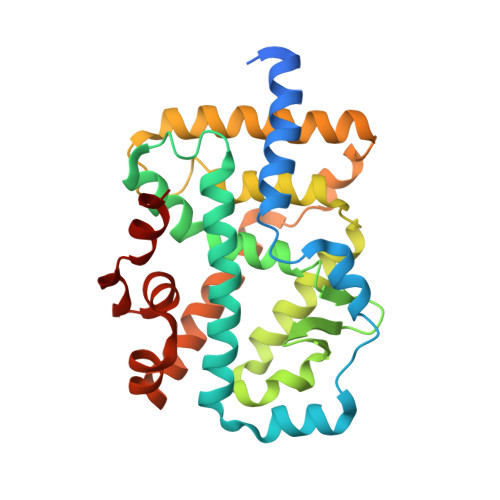Structural studies unravel the active conformation of apo ROR gamma t nuclear receptor and a common inverse agonism of two diverse classes of ROR gamma t inhibitors.
Li, X., Anderson, M., Collin, D., Muegge, I., Wan, J., Brennan, D., Kugler, S., Terenzio, D., Kennedy, C., Lin, S., Labadia, M.E., Cook, B., Hughes, R., Farrow, N.A.(2017) J Biol Chem 292: 11618-11630
- PubMed: 28546429
- DOI: https://doi.org/10.1074/jbc.M117.789024
- Primary Citation of Related Structures:
5VB3, 5VB5, 5VB6, 5VB7 - PubMed Abstract:
The nuclear receptor retinoid acid receptor-related orphan receptor γt (RORγt) is a master regulator of the Th17/IL-17 pathway that plays crucial roles in the pathogenesis of autoimmunity. RORγt has recently emerged as a highly promising target for treatment of a number of autoimmune diseases. Through high-throughput screening, we previously identified several classes of inverse agonists for RORγt. Here, we report the crystal structures for the ligand-binding domain of RORγt in both apo and ligand-bound states. We show that apo RORγt adopts an active conformation capable of recruiting coactivator peptides and present a detailed analysis of the structural determinants that stabilize helix 12 (H12) of RORγt in the active state in the absence of a ligand. The structures of ligand-bound RORγt reveal that binding of the inverse agonists disrupts critical interactions that stabilize H12. This destabilizing effect is supported by ab initio calculations and experimentally by a normalized crystallographic B-factor analysis. Of note, the H12 destabilization in the active state shifts the conformational equilibrium of RORγt toward an inactive state, which underlies the molecular mechanism of action for the inverse agonists reported here. Our findings highlight that nuclear receptor structure and function are dictated by a dynamic conformational equilibrium and that subtle changes in ligand structures can shift this equilibrium in opposite directions, leading to a functional switch from agonists to inverse agonists.
Organizational Affiliation:
Departments of Small Molecule Discovery Research, Ridgefield, Connecticut 06877-0368. Electronic address: xiang.li@boehringer-ingelheim.com.
















